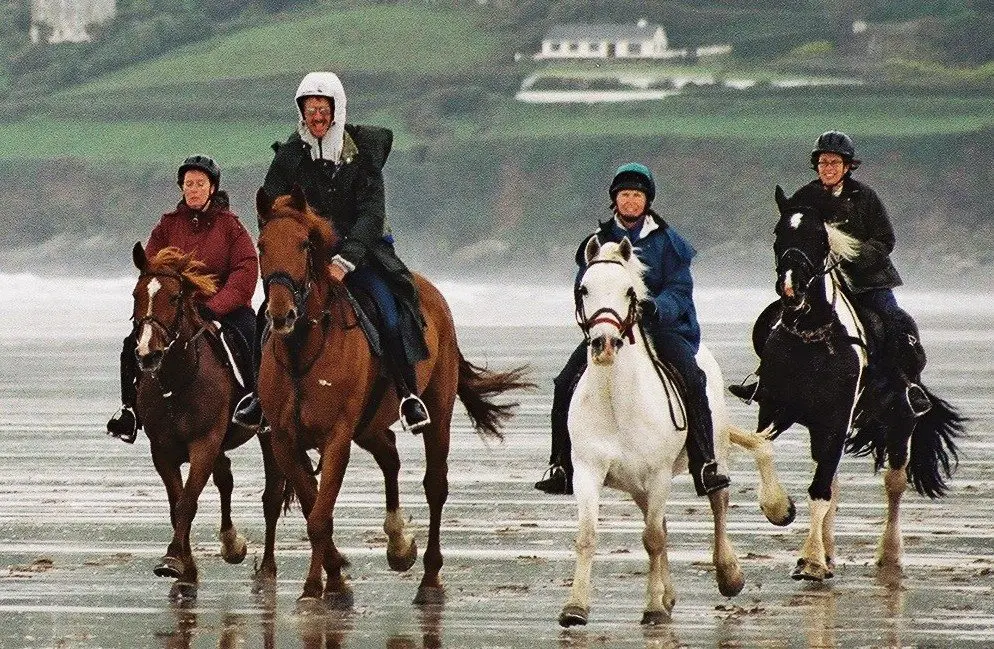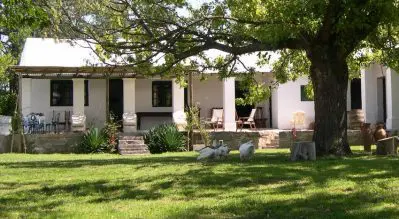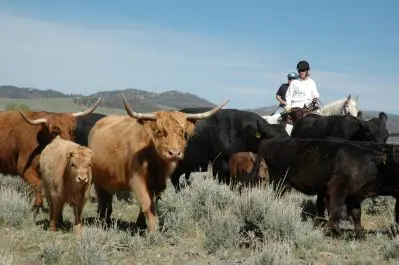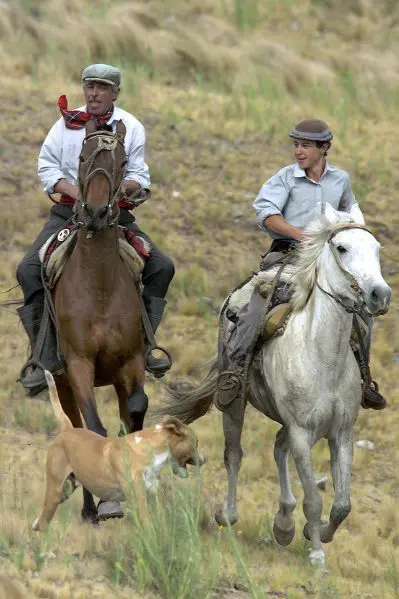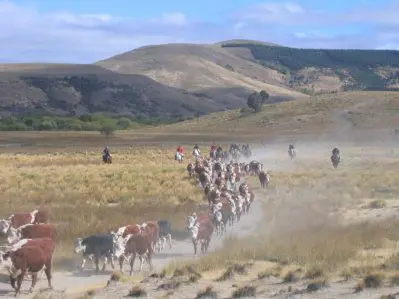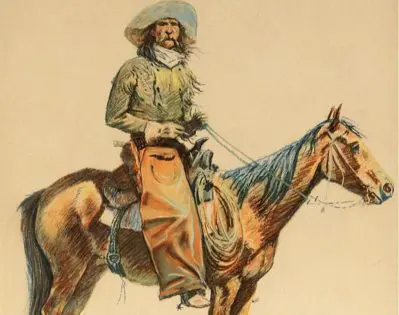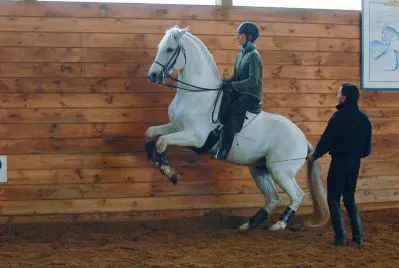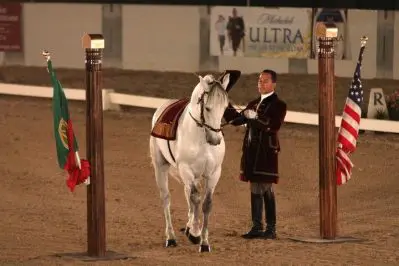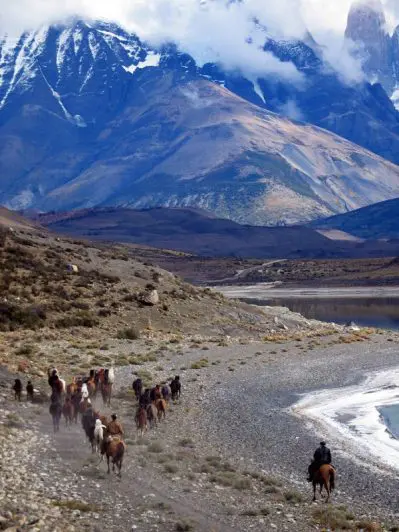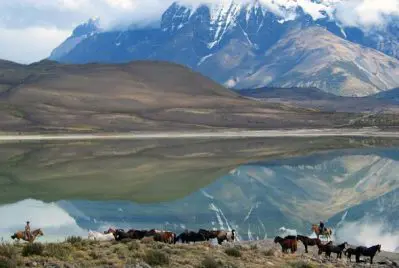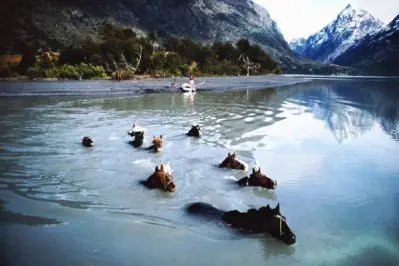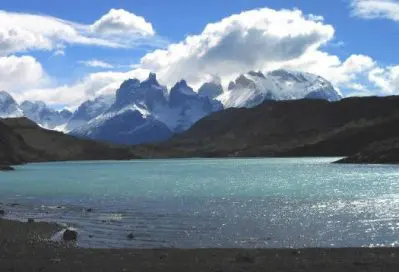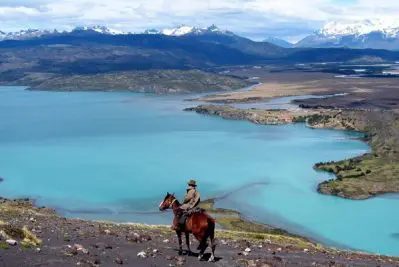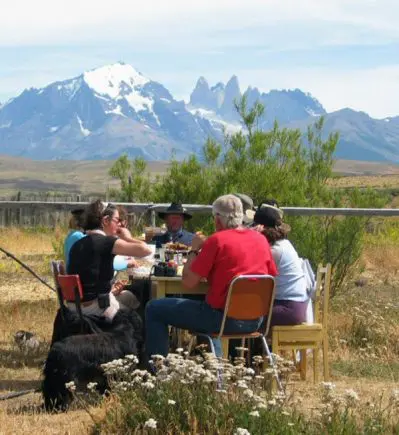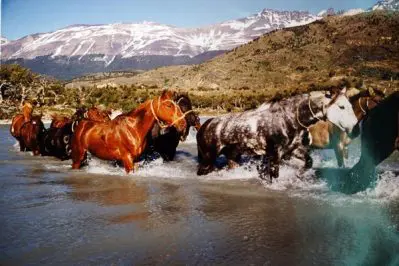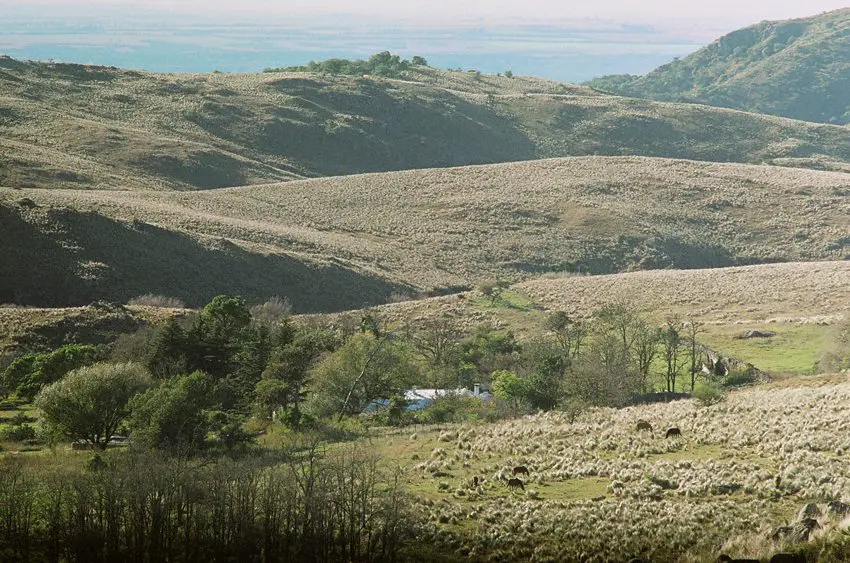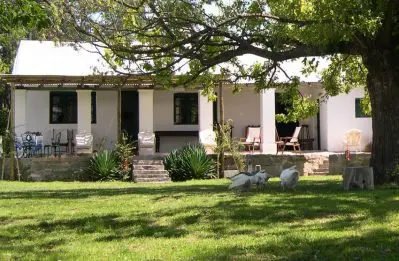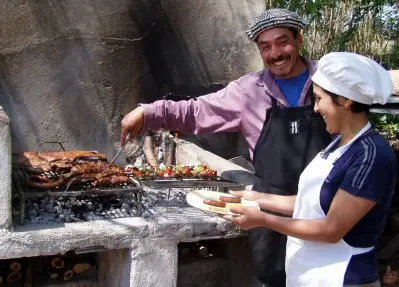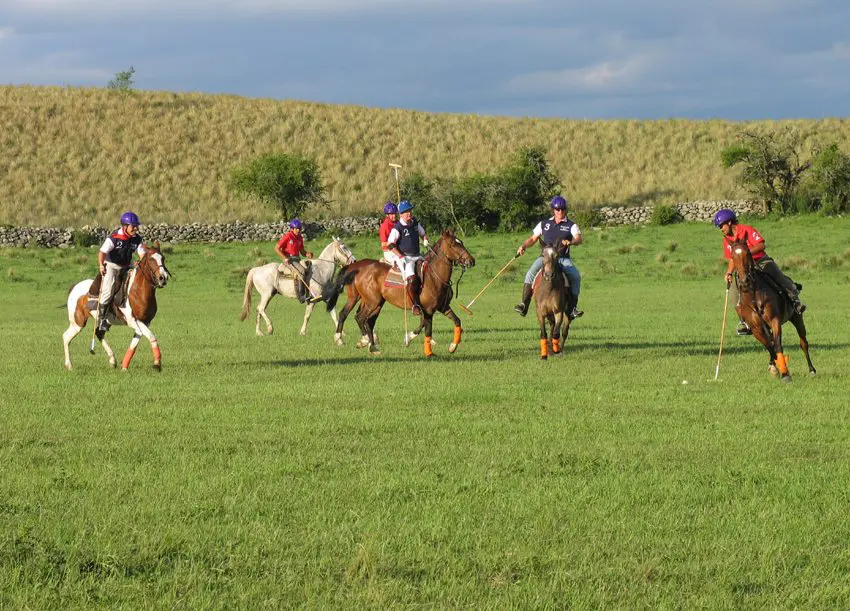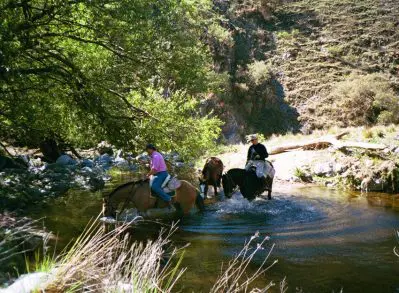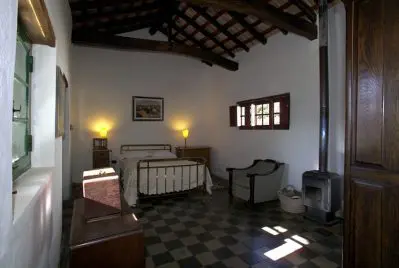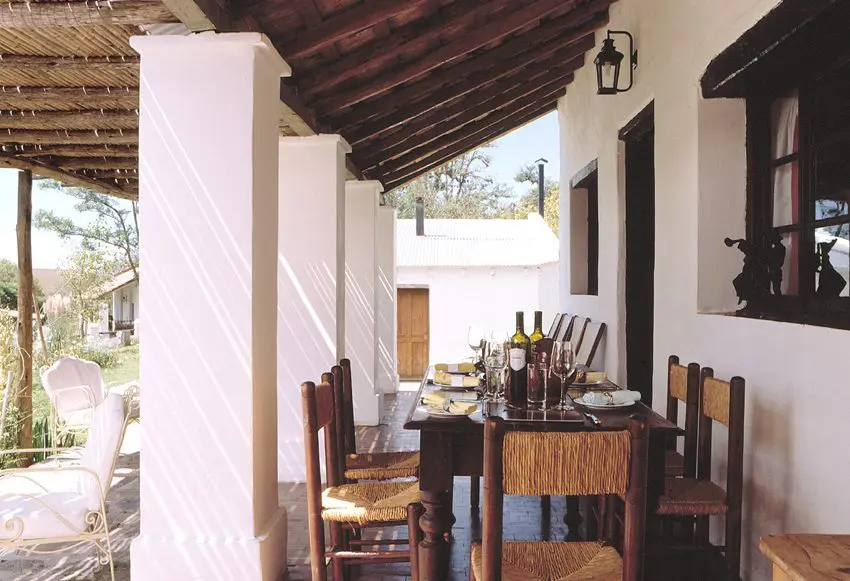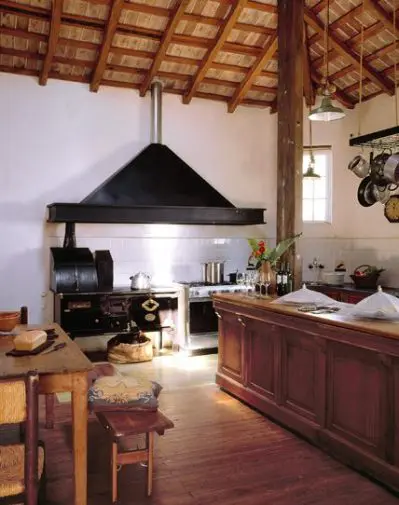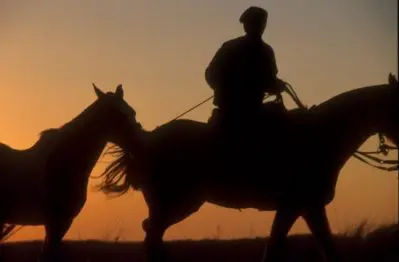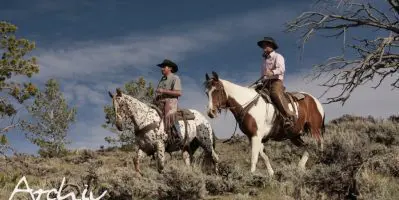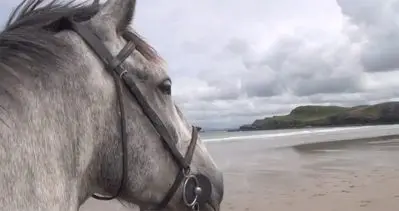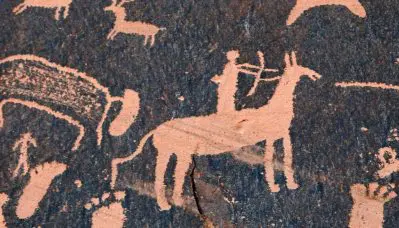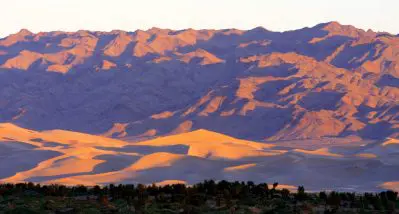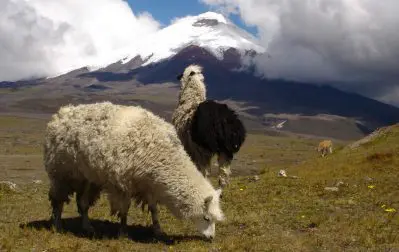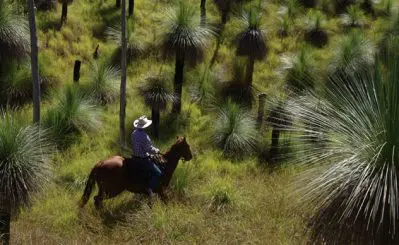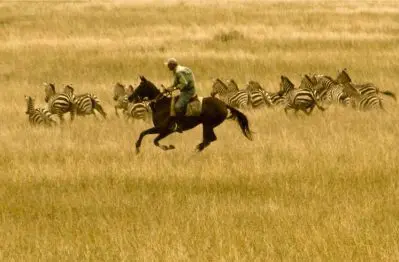Of Gauchos and Good Times

The ranch is nestled amidst rolling green hills.
Estancia Los Potreros is a 6000 acre ranch located about 1 hour outside of Cordoba, Argentina, the second largest city in the country. It is about an hour’s flight from Buenos Aires. At an elevation of 4,000 feet, the ranch has been in the same Anglo-Argentinean family for four generations and is managed and operated by the owners, Kevin and Lou, a husband-wife team. Los Potreros translates to “the gates”, and is so named because of the number of gorgeous old stone walls that encircle and divide the ranch into various pastures. The ranch and surrounding area is very green, lots of rolling hills and buttes, but you also encounter a lot of rock, hence the stone walls. They have 500 head of Aberdeen- Angus cattle, 120 horses and also raise their own sheep and pigs.
Kevin and Lou can take a maximum of 12 -14 guests at a time. There are two rides per day except for Sundays, when there is only one. Guests ride once on the day of their arrival, in the late afternoon. The morning rides begin around 10 am with lunch served around 2 or 3, and the afternoon ride leaves around 5 pm.
Guests are welcome to stay for any length of time, leaving and arriving on the dates that suit them best. There are no formal, set weeks; people constantly come and go. The ranch is open all year, except for the month of May. In the winter (June through August), it is dry, pleasant during the day and cold at night. In the summer, it is wet (you might encounter a rain storm during your stay, but it won’t rain for days on end) and very green with warm-to-hot days and temperate evenings.
The ranch has a swimming pool and lovely grounds to stroll, should a guest want to take a morning or afternoon off from riding. If you’d like to go into Cordoba for the day, an all-day taxi can be arranged for around $125 – $150 US Dollars. The taxi will seat 4 people, and the cab driver will take you to places of interest in Cordoba and wait while you sight-see or shop. Lou and Kevin happily arrange this for their guests.
Getting There
Los Potreros is a 40 minute drive from the Cordoba airport. Transfers to and from the airport are provided for guests at no extra charge. A local taxi will pick up guests at the airport as they arrive (there is no need to wait for other guests’ flights) and drive them to the ranch. A rental car is not necessary, nor is public transportation an option.
First Impression

The ranch charmed us from the start.
Los Potreros made an incredible first impression as we drove up the very long gravel drive. We saw gorgeous stone walls, lush fields, cattle happily grazing and beautiful horses. When we arrived at the main house, where guests gather for meals, Lou and Kevin awaited us, dressed in traditional Argentinean riding garb. They were standing outside on the porch with their dogs, and they offered a tray with a “welcome lemonade”. This wonderful touch made everyone feel very welcome indeed and was a sign of how attentive to detail the hosts would be throughout our week there. The grounds were immaculate, as were the rooms. You immediately felt the relaxing, happy atmosphere.
Staff
Lou and Kevin were our hosts, and they were most entertaining and conscientious. They have hired locals as cooks, maids and gauchos. They also employ 4 foreign, English-speaking guides. Each ride has both a native gaucho leading the ride, setting the pace, and an English speaking guide riding in the rear who can enhance the ride with stories and information about flora and fauna. Lou and Kevin typically ride with their guests once a day, and one of the foreign guides accompanies the group during the other ride.

The local cooks introduced us to their traditional specialties.
At dinner, the guests dine with either Kevin or Lou (they switch off nights with guests) and a foreign guide, who stays up with the guests until they retire for the evening, happily refilling drinks and engaging in entertaining conversation. A foreign guide also serves breakfast in the morning. The staff, both local and foreign, were dedicated, hard-working and very eager to please. They were all excellent. Lou and Kevin clearly knew more about the history of the ranch than the foreign guides, so rides with them contained more interesting information.
Horses
These were, hands-down, the finest horses I have ridden on any Equitours vacation. There are about 120 for 12 guests. They breed about 10 foals a year and buy horses as well. The gauchos train the home-bred horses on site and are paid extra for each horse they successfully train, so there is a lot of incentive to train them well. There is a mixture of Criollo horses and Peruvian Pasos, which are gaited horses. Both the Criollos and Pasos at Los Potreros are much larger and better-built than the other Criollos and Pasos I have encountered. They have sleek coats, are beautifully groomed and fed very well. The guests ride either all Criollos or all Pasos during each specific ride, which is important to note. If someone goes there wanting to ride only gaited horses, they will not be able to ride a gaited horse on every ride. They will ride gaited horses about half of the time.
The horses are extremely well-trained and finely tuned. You ride a different horse every ride, maybe repeating one or two during the week. Lou selects horses for her riders and does an excellent job matching personalities. She is also very open to feedback and willing to adjust mounts if someone is not pleased with a specific horse. The gauchos do all of the farrier work, so shoes are clinched and checked every morning. As a result, there were no problems with loose shoes on the trails and all horses moved quite soundly. There were no signs of saddle sores, and very few signs of bite marks. The horses live together in herds out in the pasture (divided by breed, Criollos in one pasture, Pasos in another), so they are very comfortable with one another when riding. Guests may ride in any order, and we were welcome to change order throughout the ride. We experienced no kicking, no biting, no vices at all…no attempts to graze, no slow-walking. As stated above, they were very finely tuned animals. They were also very friendly with people and loved being petted before and after rides. We used mounting blocks to get on the horses.
Tack
They have three types of saddles: 2 types of English (polo and military) and Gaucho saddles. Each horse has its own saddle, so you ride in a different saddle every time you go out, which is also important to note. If you really like a specific saddle, you will not ride in it every time because you will be riding in a saddle that fits the horse. If the saddle was really important to the rider, I’m sure Lou could find other mounts for the rider that used the same type of saddle. The saddles all fit the horses very well.
The polo saddles have a lower back and front and are most similar to a close-contact English saddle. The English military saddles have a very high back and front, so you are really held into position. The Gaucho saddle is much wider. It has a broad flat front and back and looks like a large rectangle draped over the horse. Although comfortable, they really encourage the lower leg to be quite far forward, since this is how the gauchos ride. If you fight having the lower leg forward, it becomes less comfortable. You definitely get a wider stretch through the hips in the gaucho saddle. Each saddle comes out with a gorgeous, huge sheep skin draped over top as a seat save. I found all of the saddles to be very comfortable, well-cared for and made of very high quality leather.
All of the horses neck rein, and the bridles are made of beautiful leather. The horses wear lovely, thick leather halters with the bridles over them, so that they can be easily tied up during picnic rides. The reins are thick and a pleasure to hold. The tack room is gorgeous…perfectly clean, filled with fine tack. It is situated right next to where guests mount and was certainly an impressive sight.
Water bottles and saddle bags are provided upon request. The gauchos carry bottles of water as well as lemonade and cups with them in their own saddle bags, so guests are welcome to stop for refreshments regularly.
Riding
At Los Potreros riding is done in a hybrid English-Western style. They neck rein, as we do in Western riding, and the horses are extremely responsive. You are welcome to post or sit the trot, as well as sit the canter or half-seat, whichever is most comfortable for you. You are encouraged to sit in the saddle at all gaits, since that is what the gauchos do and that is how the horses are trained, but it is up to each guest. All three types of saddles have English style stirrups, but the Gaucho saddle is a little more reminiscent of a Western saddle, with its larger size. Going up hills, they ask that you lean forward a little to help your horse, but they do not ask you to actually get up out of the saddle.

On one of the picnic rides we had the opportunity to play polo with the gauchos.
We rode 5 – 6 hours per day. Most days you go out twice, but on two days we had picnic rides. On one of the picnic rides the gauchos and foreign guides packed lunches, and we rode to a beautiful swimming hole where we stopped for a few hours to read, swim and jump off rocks into the water. The other picnic ride was the day we played polo. In the morning we played polo, then had lunch at the polo site, and finally stopped by Lou and Kevin’s house on the way home to play gaucho games (like pole bending). It was a great day.

The gauchos were always ready for action.
One of the best aspects of Los Potreros was how varied the riding activities were. We went on trail rides, picnic rides, played polo and gaucho games and herded horses and cattle. We also had the opportunity to ride to El Chiviquin, the cattle headquarters of the ranch, and watch the gauchos lasso and dip the calves in fly protectant. Each day was a new adventure, and it kept guest energy and interest up throughout the week.

The rides covered varied terrain.
The pace of the ride is varied due to the rocky terrain. We had many opportunities for good gallops, but we also walked quite a bit. As in most Latin American countries, there is not much trotting done. We were either going on long canters or extended gallops, or we were walking. They are very amenable to adjusting the pace of the ride to the ability and desires of the group. Our group liked to go fast, and they made sure we were able to do so frequently. Different groups were sent on rides according to skill level, accommodating people who had never ridden before all the way up to highly advanced riders. In addition, our hosts were able to accommodate our particular group by sending out extra guides with us, so that we could all ride together at times, although we had a variety of ride levels in our groups. With the extra guides, the more experienced riders could go on fast canters while the extra guide could lead the less experienced riders on slower canters, and we could all catch up at the end of the canters. This worked out well, and it was nice for the group to ride together sometimes.
Accommodations
The accommodations were very neat and well-maintained. They are not fancy, but they are lovely. Decorated in the typical local style of the region, they are cleaned daily by very attentive maids. Free laundry service is also provided any day you would like, though all clothes are line-dried, and depending on weather, it can take a day or two to get your clothes back, which is important to note.

The accommodations were decorated as is typical of the region. The maids brought fresh flowers from the garden to our room daily.
While they can take 12 – 14 guests, there are actually 8 rooms/cabins. There is a cute stand-alone single cottage which is very charming and has lots of natural light. There are two rooms that are physically attached to the main house, where meals are served, and each of those can accommodate two people. In addition there is a stand-alone building that would be great for a family, having three bedrooms, one of which has bunk beds for kids, and two bathrooms. Finally there is a third stand-alone building that is quite large and has two bedrooms, each with adjoining bath. In this suite is also a large sitting room and even a kitchen (though it was not used while we were there!). All rooms have private bathrooms.

Some meals were served on the picturesque veranda.
Many thoughtful touches have been taken with the rooms as well. The maids put in fresh-cut flowers from the ranch each day, which were a lovely sight and smell to come home to.
There is free internet available in the main house where we gathered for meals. It is wireless, but not terribly fast, which is important to note. Downloading large files would be a frustrating endeavor! People needing to conduct business while at Los Potreros should be warned that while they have internet access, it is not the fastest or strongest of signals. It is perfectly adequate for checking and writing emails. The hosts ask that no one use internet during meal time, cocktail hour or tea time. That way the holiday isn’t disrupted by continuous computer use. Appropriate times for using computers and internet are after breakfast (before the first ride) and after lunch (during siesta).
Food
Meals are included in the ride cost, as are alcohol and other beverages. There is a full bar in addition to beer and red and white wine. The hosts are very generous with the alcohol, always willing to pour and encouraging people to have as much as they want.
Tea or coffee is brought to each person’s room in the morning, which is such a luxury! They bring the tea or coffee at 8 or 8:30 and breakfast is at 9. Fresh fruit, freshly squeezed juice, cereal, as well as hot breakfast to order (think eggs and bacon however you like it) are served to start the day off right.
Lunch is typically at 3, depending on when the morning ride returns. Beer, wine, juice, soda and water are offered with lunch. Lunch is plated and served to you, so it is not a buffet and there is not a huge amount of choice. They accommodate vegetarians, vegans and any dietary restrictions.
Guests are invited to tea at 5 pm before the afternoon ride goes out. Snacks are served as well.

Many a delicious meal originated in the spacious kitchen.
Cocktail hour begins at 8 or 8:30 with light hors d’oeuvres, and dinner is at 9. Again, dinner is plated and served to you, so you eat what you are given. The meals are very delicious, very balanced and made with fresh, home-raised ingredients whenever possible. There is a bell at the dining room table, which Kevin or Lou rings whenever service is needed. When the bell rings, waitresses come to clear the plates and offer the group seconds. Dessert is served with dinner.
If anyone is ever hungry between meals, they are welcome to go to the kitchen for a snack. While the tap water is safe to drink, bottled water is provided at all meals, in the rooms and on the rides, so there is never a lack of fresh, bottled water!
Other Activities
As noted, there is a nice pool, and swimming was also offered on the picnic ride when we went to the swimming hole. It is a lovely ranch to explore on foot as well, for those who are interested in hiking or running. Also, the hosts are very willing and able to accommodate non-riders who are interested in watching the polo and the gaucho games, but not actually taking part. At some point during the week, almost every client on our trip took a ride off to rest, read, relax or swim. Estancia Los Potreros is a place with a great energy, so just enjoying the surroundings is a lovely way to spend the afternoon.
Extra Costs
 Gratuities are not included, and it is suggested that each guest leave $15 – 20 per day if they received excellent service. Every client in our group certainly felt the gratuity was warranted, given the level of service. Any form of currency for gratuities is gladly accepted, be it pesos, dollars, euros, pounds, whatever!
Gratuities are not included, and it is suggested that each guest leave $15 – 20 per day if they received excellent service. Every client in our group certainly felt the gratuity was warranted, given the level of service. Any form of currency for gratuities is gladly accepted, be it pesos, dollars, euros, pounds, whatever!
Please note that to enter Argentina, Americans are required to pay a $140 visa tax per person when they land in the country. It can be paid with credit card or cash. This visa tax is good for 10 years, so if you return to the country within 10 years you will not have to pay it a second time.
Ride Review by Hadley Fox
March 2012



